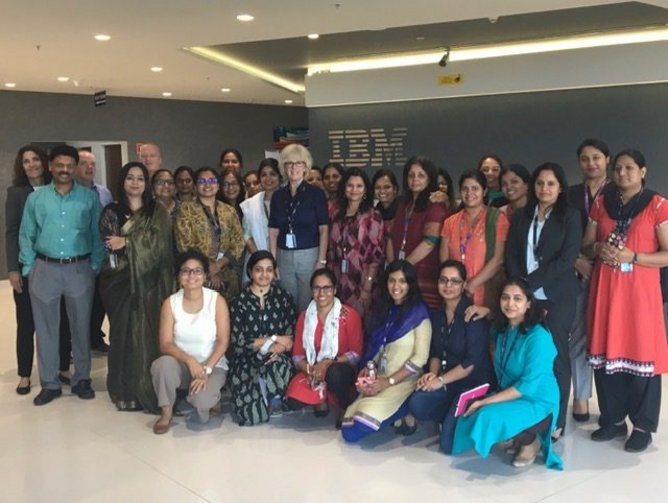When IBM appeared in 1911, 13 years later adopting the name International Business Machines, it was already a pioneer in automation, developing machines that made calculating, tabulating, measuring – and the like – faster and less labor-intensive. In some fundamental ways, its relationship with business has been consistent. Throughout the growth of computing, the internet, and now digitization, migration to the cloud, AI, blockchain and quantum computing, it has continued to lead, partner and innovate, leveraging possibilities and pushing the envelope.
Engineered solutions are still IBM's stock-in-trade, even if these solutions are very different in nature from the mechanical advances of a century ago. The faster the industry changes, the more exciting it gets, says Bridget Karlin, Global Managing Director, CTO and VP at IBM. “IBM is an innovator and continues to lead the industry in new patent inventions. AI, analytics, blockchain, cloud and advanced computing are all technologies that emerged from deep investment in our talent and R&D.” One thing that's very important to a CEO or CIO today is the speed of delivering the value of innovation out to their customers: IBM helps them do this.
Client first
Of the many transformations that IBM has taken to maintain its lead for so long, perhaps the most defining is its customer-centric approach. “Our priority is our clients. We apply our technology and our expertise to help solve their problems and to enable new capabilities. That is the hallmark by which we measure our success, ” says Karlin.
She has the responsibility to look after IBM's clients' IT environment, from their infrastructure to their security to their applications and data. “We work with our clients to ensure they have everything necessary to successfully transform the business. We do this by leveraging AI, automation, hybrid cloud and security technologies to enable transformation while modernizing their environment. Digital transformation is driving business acceleration, and IBM is one of the technology leaders enabling companies globally.”
In addition to technology, IBM utilizes new ways of working, using DevSecOps and Agile as part of digital transformation. Practiced together, DevSecOps and Agile improve the quality of the code as well as help to accelerate the time to deployment. Agile practices permeate development work, says Karlin, and tools such as IBM’s Urban Code helps customers to automate software deployment and achieve greater agility. “As software developers adopted Agile and DevSecOps practices, aiming to reduce software development cycles to weeks or even days, the traditional 'tacked-on' approach to security would have caused bottlenecks. DevSecOps reorganizes roles and practices to encourage collaboration across development, operations, and security to streamline development lifecycle, release-engineering, implementation and maintenance.”
Site reliability engineering (SRE) is another important model for news ways of working that IBM helps customers to utilize. Karlin adds, “SRE incorporates aspects of software engineering and applies them to infrastructure and operations problems to create scalable and highly reliable software systems. We help clients adopt SRE to evolve from traditional defect/fix processes to more end-to-end application-centric practices.”
A new, accelerated digital world
At least 75% of companies will say that Covid-19 underscored the need to accelerate their digital transformation, Karlin comments, “Setting up employees to work remotely, in a safe, secure manner so that all the privacy and security controls of the business are implemented and monitored, presented challenges to companies worldwide and exposed the need for broader, more secure digitization.” It’s her job to enable client digital reinvention with a global team of distinguished engineers, data scientists and advanced architects. She also oversees open source solutions offered to clients, which is an important focus since IBM acquired Red Hat in 2019. “With a clear vision of the technology roadmap, we make sure that IBM can deliver a common set of tooling and seek out opportunities to improve performance, reduce cost, increase control and visibility of the client’s IT environment as we help them accelerate their digital transformation.”
With a geographically dispersed organization behind her, it's essential for Bridget Karlin to work on a matrix basis. This means defining a compelling technology strategy, with clearly defined deliverables and making sure her leaders are motivated and inspired to drive effective collaboration globally. “Effective collaboration requires clear purpose, supported by technical communities that share knowledge, best practices and work together to ensure the best outcomes are delivered. This community culture is an essential component to our innovation and client success.” Karlin adds, “And you do not have to be a developer to be an innovator; ideas come from many different skill sets. So my job, in addition to delivering value to clients, is to build technical communities across a wide range of individuals with mechanisms that encourage partnership for both our internal and external ecosystems, engaging partners in business and academia as well.”
Co-creation and AIOps
IBM's collaboration with its clients sets it apart. “As a technology leader, throughout my career, I have admired the range of interesting ideas and innovative technology developed by others as a result of co-creation. For example, AI for IT Operations, or AIOps, is a solution we developed as a result of client co-creation, where we apply AI to the data flowing through the client’s IT operations, being able to analyze that data throughout those operations and generate insights that can help identify and prevent problems or enable new capabilities that provide competitive advantage. ”
As an example of AIOps in practice, she gives the client case of a car rental agency: “We helped them bring together the data from different sources including the mobile devices they use to rent cars, as well as the back end systems running the IT environment. If the mobile devices failed whereby, they could no longer rent the cars, with AIOps, we were able to reduce the time to identify and resolve the issue from days and weeks, to just minutes. The client can now immediately locate the application and the server that is causing the problem and know the actionable insights to fix the issue. This example of advanced technology, working across multiple vendor technologies in a client’s heterogeneous IT environment - ingesting data, analyzing it and generating actionable insights, illustrates how the IT Ops person can do their job more efficiently, get a solution out to the user and prevent the issue from recurring. The co-creation approach helps you focus on the solutions that give clients the highest value.”
With access to vast amounts of data, added to advances in software and computing power, Bridget Karlin enthuses about the ability of AI to change society for the better. “It's not just changing the way we work; it's also changing the way businesses operate and carry out their digital transformation.” For example, as the pandemic disrupted global supply chains and travel, with ships waiting out at sea unable to dock, IBM was able to utilize AI to help these businesses and also put in place safety measures to protect the workers involved. The same applies in other industries – such as with the healthcare sector where AI has been used to identify patients targeted for clinical trials or to keep track of rapid mass vaccination programs.
The power of data
Data is an inexhaustible mine. “I am excited every time I think about the possibilities that data opens for us. While cloud has been a transformational technology for quite a few years where we are now really understanding the value of a hybrid, mulitcloud environment, AI is proving to be an even more influential technology.” Karlin adds, “AI is one of the greatest opportunities of our time, transforming how we work and live, and helping solve the world’s toughest problems of today, and tomorrow. However, it’s important to recognize that all AI is not equal. Our biases and prejudices can easily enter AI systems through the data that we create, collect, train, or process. As stewards of AI and its models, we need to take action to ensure the decisions AI is making are explainable, unbiased, and transparent.”
Quantum computing is another great example of advanced technology that excites Karlin. “IBM has made quantum computing more accessible to industry and academia alike. And its possibilities are unfolding fast. Challenges like having more efficient food supply, a cleaner environment, safer exploration are just a few areas where IBM’s Quantum computing is making our world better. Humanity's greatest challenges demand entrepreneurial thinking, advanced technology and a model of co-creation: this is why I am in the industry.”



